by Annelies Kusters, Jordan Fenlon and Jemina Napier
In the weekend of 25-26 November 2017, the fifth Bridging the Gap (BtG) conference was hosted at Heriot-Watt University. The aim of this conference series is to work towards bridging two gaps: first, the gap between academics (involved in Deaf Studies and sign language research) and deaf community members; and second, the gap between deaf and hearing academics within these fields. While the second gap triggered the organisation of the first BtG conference in 2014, the fifth iteration of the conference mostly focused on the gap between community members and academics. It was the first time that BtG lasted two days rather than one, and it attracted 120 participants: community members and academics hailing from all over the UK, the largest audience so far. The conference was heavily discussed on social media, particularly on Twitter (see #BTG5). The core organising committee consisted of Jemina Napier, Jordan Fenlon and Annelies Kusters, and others who have worked with us to plan the conference included Steve Emery, Dai O’Brien, Heather Mole and Emmy Kauling, and a number of student volunteers.

Annelies, Jemina and Jordan.
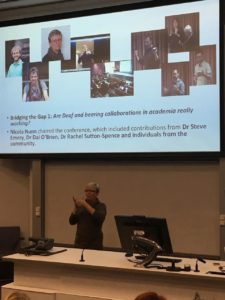
The conference started off with an introduction by Nicola Nunn, who organised the first BtG conference in Preston. She introduced the BtG series, emphasising that she was very happy to see that the conference was not an one-off and is now an established one in the British deaf conference landscape.

After Nicola, Jemina Napier took the stage to give the audience an impression of the kind of research and community work we are doing here at Heriot-Watt, where the BSL section has recently exponentially grown.
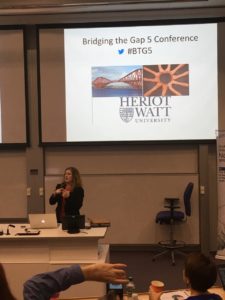
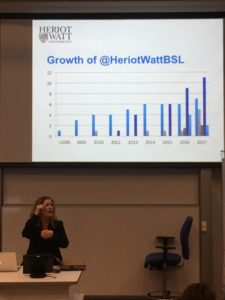
After opening the conference in this way, Hillary Third (Equality Unit, Scottish Government) and Frankie McLean (Deaf Action) gave a keynote presentation focusing on the implementation of the BSL (Scotland) Act. Hillary and Frankie explained that the aim of the Act is to make “Scotland the best place in the world for BSL users to live, work and visit”. The BSL National Plan for 2017-2023 contains 10 long-term goals and 70 actions in the next 3 years (covering early years and education training and work; health; culture and the arts; transport; justice and democracy) and a further set of actions will be published in 2020.
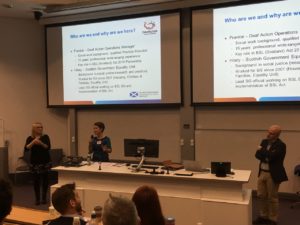
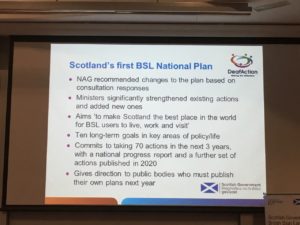
The Plan was constituted after extensive consultation: the National Advisory Group (NAG) has been successful in engaging large numbers of Scottish deaf people in the BSL Act. Not only was the NAG a great input for the Scottish Government, it also served as an instrument of empowerment. Several feeder NAGs such as a parent and youth NAG had input into the general NAG. An inspiring video was shown of 2 deaf teenagers who were involved in the youth NAG, talking about the valuable experience of being involved, since they “are the future”. The Act is a great example of working with and for a deaf community in order to create better life conditions for deaf people. This opening session was livestreamed (https://www.facebook.com/HWUBSL/).
When we were planning BtG5, we already knew during our first meeting that we didn’t want to organise a “typical” conference consisting of presentations to disseminate research findings. Indeed we thought that if we really wanted to work towards bridging a gap, we would need an interactive format, designed in order for people to be able to express a range of thoughts on the “gap” under discussion. So the three sessions that followed the keynote presentation were interactive.
The first interactive session was based on the TV programme Dragon’s Den, where entrepreneurs could pitch an idea for a panel of venture capitalists who would decide if they would fund the particular project or not. Jordan Fenlon facilitated this session at BTG5, asking: “what would you do if you had £2 million for a research project?”

The aim of this panel was for academics to learn about what kind of research deaf people find important and for the audience to get insight in the kind of thinking that’s involved in crafting a research proposal. Panelists for example pointed out the need to use buzzwords such as Thomas Lichy’s use of the word “hate crime”. They also pointed out that sometimes similar or related research has already happened (the dementia proposal); or that an idea (the deprivation project) had been previously pitched but not in a successful way. They said that a project such as the BSL corpus project would preserve old signs and regional variations, but a funder would require it to contribute to new academic theory, which is often a big challenge in applied projects. The idea that won the audience vote was Audrey Cameron’s: she suggested to work with Science Centres to give science teaching tessions to deaf children in BSL, and study how we think about science in sign language: a wonderful combination of doing exciting research in combination with direct benefits for deaf children.
A few academics and community activists/representatives came forward to pitch an idea that they had prepared in advance – the range of ideas covered:
BSL deprivation of deaf children (Tom Lichy)
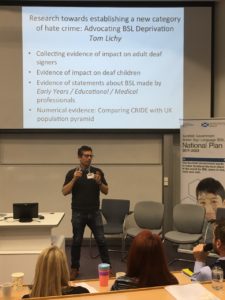
A Scottish BSL corpus project (Gary Quinn)
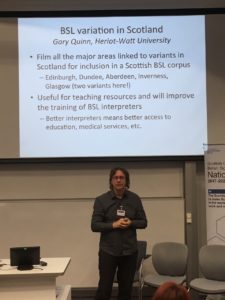
The Deaflympics 55 dB cut-off (Philip Gerrard)
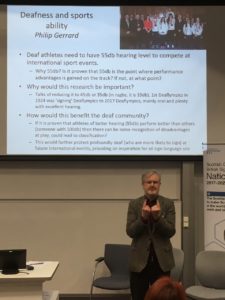
Sign language use in deaf people with dementia (Avril Hepner)
Mouthing in BSL (Adam Schembri)
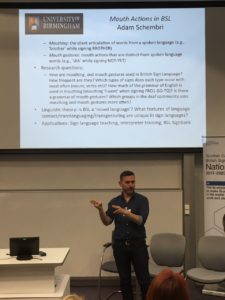
The impact of isolation on mental health (Herbert Klein)
And science learning in BSL (Audrey Cameron)
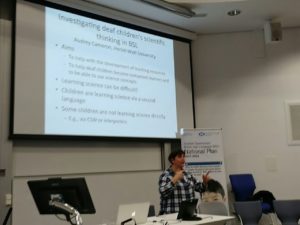
The panel consisted of academics and community representatives: Bencie Woll, Terry Riley, Graham Turner, Gordon Hay and Emma Ferguson-Coleman.
The second interactive session was called “Heriot Watt goes to Hollywood”, facilitated by Annelies Kusters and Gary Quinn, in which 6 short films were showed that were created by Heriot-Watt BSL section staff, PhD students, postdocs, BSL students and community members. The issues included: deaf people not learning about research findings after a project is concluded; having to sign epic consent forms in English; working with interpreters during research projects; the fact that participants often don’t want to admit when they need more clarificaton from academics; deaf people not knowing about Deaf Studies concepts but hearing interpreter students do, which can intimidate deaf people; deaf academics “leaving the community behind” to give presentations at international conferences and publish books. With the films, we tried to tackle issues in a humorous albeit serious way.
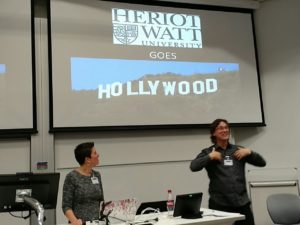
The Hollywood session led to lively discussions, and during the next session on the next day, a manifesto workshop was facilitated by Dai O’Brien, Jordan Fenlon and Annelies Kusters, in order to address the same issues with the aim of taking action in the shape of a manifesto. Everyone got involved, the discussions were recorded, and Dai, Jordan and Annelies will take this forward. They will summarise the videos and use the summary to create a first rough draft of the manifesto which will then be presented and further discussed during the next BtG conference.
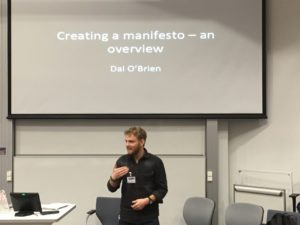
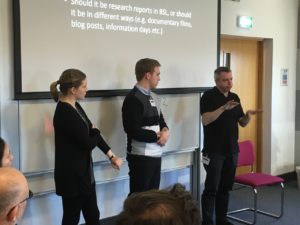
Some issues that were discussed during the Hollywood and manifesto sessions included: how are research findings made accessible and attractive for community members? In the case of participants who directly contributed to a research project, it is important to ask how they want access to the findings, eg. some might want a summary in BSL and others might want the full article in English. In case of the broader community there are a number of options. Who wants to watch a two hour signed report on academic topics? Other options include short signed summaries, documentary films, interactive websites and texts in plain English. It is important to make research meaningful and interesting, and that also often means that reports should be kept short. When giving live presentations, it’s important to consider where the event is hosted: a relaxing/safe space such as a trusted deaf club with a pint in the hand, or pizza in a chilled out place, fosters a very different kind of atmosphere than an university auditorium. An issue that surfaced multiple times during the conference is that researchers are increasingly proactive in trying to make their research accessible in BSL but members of the deaf community might not know the BSL report exists (such as the earlier mentioned dementia project). So, how can people learn what research is happening and where, and where can they find it? The clever use of hashtags and Facebook groups is one means but it was also suggested that a centralised website with a “research map” would be helpful.
It is not clear yet where the 2018 iteration of BtG will be organised. We hope that during the next BtG conference, we can discuss actual examples of “good practice” in research and community involvement and impact, and how these might inform the BtG Manifesto.
***
